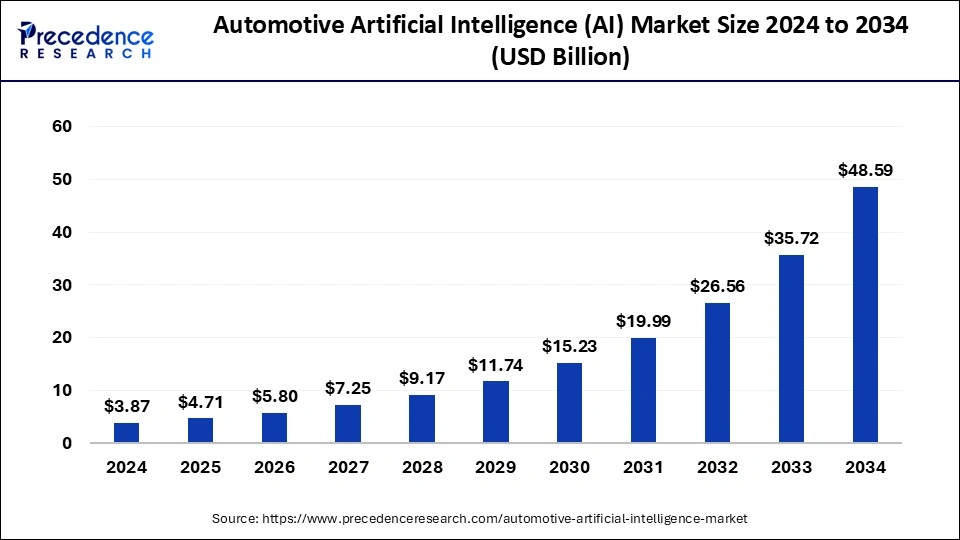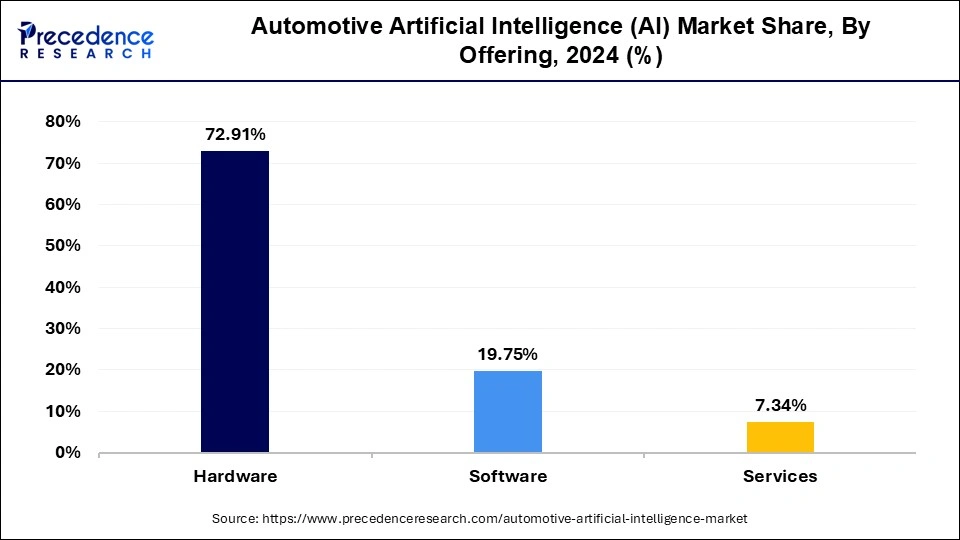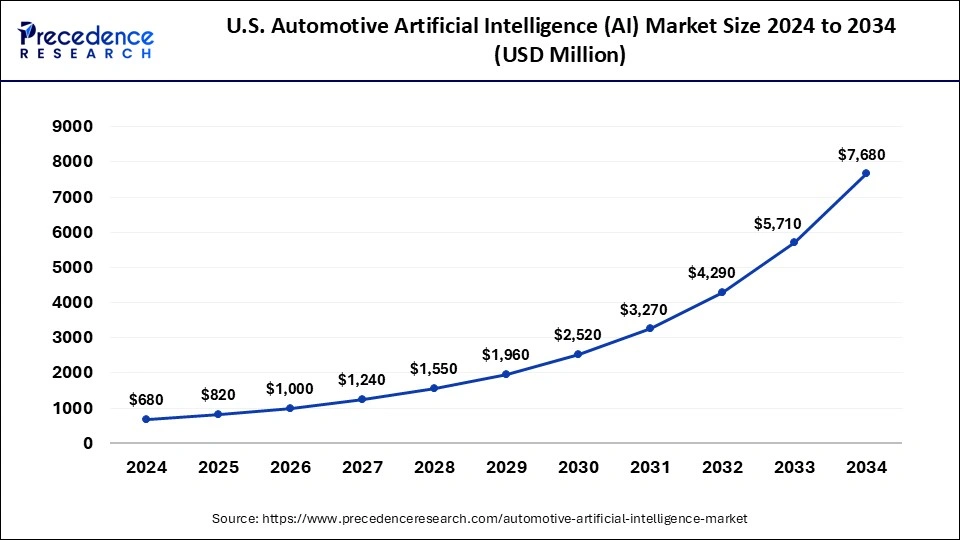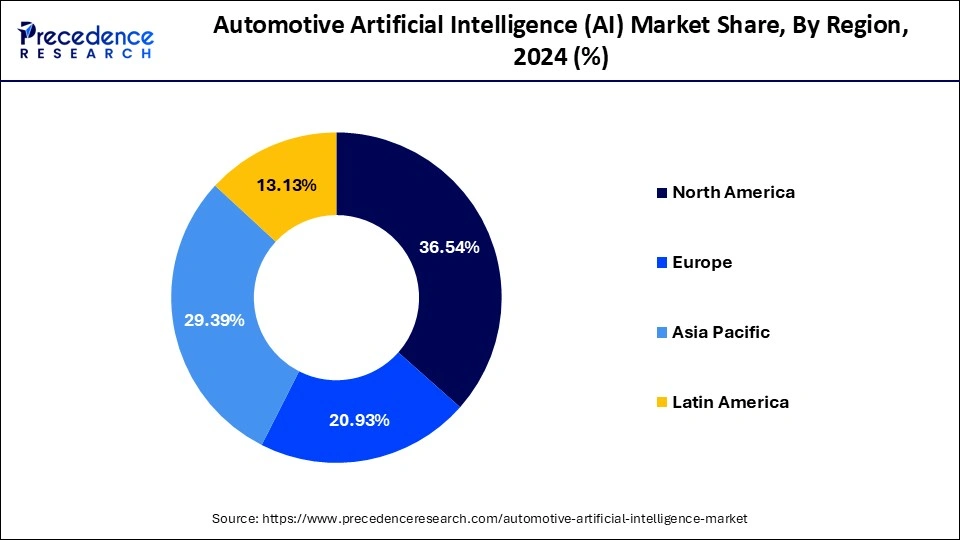List of Contents
What is the Automotive Artificial Intelligence (AI) Market Size?
The global automotive artificial intelligence (AI) market size is estimated at USD 4.71 billion in 2025 and is predicted to increase from USD 5.80 billion in 2026 to approximately USD 48.59 billion by 2034, expanding at a CAGR of 29.61% from 2025 to 2034.

Market Highlights
- North America dominated the market with the largest market share of 36.8% in 2024.
- Asia Pacific is estimated to expand at the fastest CAGR during the forecast period.
- By Offering, the hardware segment contributed more than 72.6% of revenue share in 2024.
- By Offering, the Software segment shows significant growth during the forecast timeframe.
- By application, the semi-autonomous driving segment held a 46% revenue share in 2024.
- By application, the autonomous driving segment is predicted to grow at a CAGR of 27.8% between 2025 and 2034.
- By technology, the machine learning segment accounted highest revenue share of over 34.8% in 2024.
- By technology, the natural language processing segment is expected to record a CAGR of 29.4% from 2025 to 2034.
- By process, the voice recognition segment captured around 32.8% of revenue share in 2024
- By component, the memory and storage systems segment contributed more than 23.3% of revenue share in 2024.
Market Size and Forecast
- Market Size in 2025: USD 4.71 Billion
- Market Size in 2026: USD 5.80 Billion
- Forecasted Market Size by 2034: USD 48.59 Billion
- CAGR (2025-2034): 48.59%
- Largest Market in 2024: North America
- Fastest Growing Market: Asia Pacific
Market Overview
The automotive value chain, which includes manufacturing, design, supply chain, production, post-production, "driving assistance" and "driver risk assessment" systems, is effectively implemented in AI. Automotive manufacturing services like part manufacturing & designs and work with humans to assist them in producing AI automobiles. AI use human data and algorithms to replicate human decision or thinking ability. Automobile manufacturers can simplify their decision-making process to ensure a high-quality customer experience. AI tools and equipment are already present in modern cars including an anti-lock braking system (ABS) and adaptive cruise control. Self-driving technology, which depends mainly on AI, is the next milestone that the automotive industry is driving toward.
Automotive Artificial Intelligence (AI) Market Growth Factors
One of the major factors driving the growth of the global automotive artificial intelligence market is the increase the R&D development in the automobile industry within the forecast period. Data science and machine learning technology help keep automobile organizations competitive by improving everything from research to design to manufacturing to marketing processes and automobile data analytics is not limited to self-driving cars. For instance, it is equipped with cameras, multiple sensors and radars and lidar which help in path planning and a better understanding of the surroundings are the factors that positively affect the market. Furthermore, for car manufacturers, the main goal of research and development on alternative fuels is to decrease reliance on fossil fuels by switching to the use of primary energy sources that are renewable, secure, adequately abundant, and more ecologically friendly these factors significantly drive the global automotive artificial intelligence market during the forecast period.
In addition, growing awareness of the autonomous industry is substantially driving the market. Customer demand for driverless vehicles has increased significantly, and autonomous features are much desired as some negative media reporting customers also expect semi-autonomous features for safety. For instance, according to Cox Automotive Mobility Solutions Group, 54% of people want semi-autonomous features for better and safe driving which noticeably drive the automotive artificial intelligence market.
Also, rising government initiatives for vehicle and road safety, automotive technology, telematics, and artificial intelligence can help to reduce the number of traffic accidents and improve road safety. For instance, data collection on vehicles on the road and the condition of the roads. In addition, real-time weather information and alerts may be mobile network and fast data transfer options. ultimately an effort to decrease accidents such type of initiatives tokened by government accelerate the automotive artificial intelligence market.
However, high-tech technologies increase the cost of vehicles which hamper the market growth to some extent. Furthermore, the increasing government initiatives to promote AI technology is one of the lucrative opportunities for the growth of the market during the forecast period.
Market Scope
| Report Coverage | Details |
| Market Size in 2025 | USD 4.71 Billion |
| Market Size in 2026 | USD 5.80 Billion |
| Market Size by 2034 | USD 48.59 Billion |
| Growth Rate from 2025 to 2034 | CAGR of 29.61% |
| Base Year | 2024 |
| Forecast Period | 2025 to 2034 |
| Segments Covered | Offering, Technology, Application, Process, Component, and Region |
| Regions Covered | North America, Europe, Asia-Pacific, Latin America, and Middle East & Africa |
Market Dynamics
Drivers
THE RISE IN THE DEMAND FOR AUTONOMOUS VEHICLES
Autonomous vehicles can sense the environment and drive on their own without human intervention. A human passenger is not required to drive or even be present in the vehicle at all times. Such vehicles can perform all the tasks that a traditional car can perform and that too without a human driver. This cannot be made possible without the utilization of artificial intelligence. The adoption of AI in self-driving cars with the usage of advanced ultrasonic, radar & Lidar sensors, machine learning systems, and video cameras are bringing a revolution in the automotive industry thereby propelling the growth of the automotive artificial intelligence market. Additionally, improved road safety and the promise of a reduction in the number of road accidents with autonomous vehicles are driving the growth of the automotive artificial intelligence market.
Furthermore, Senior citizens and people with physical disabilities can take the advantage of fully automated vehicles. This is further projected to generate the demand for self-driving cars in the upcoming years. Moreover, the high costs of autonomous vehicles can be managed by performing ride-sharing instead of personal transportation which can further reduce the cost of transportation. This phenomenon is projected to generate the demand for autonomous vehicles over the forecast period, thereby augmenting the growth of the automotive artificial intelligence market. Increasing popularity, awareness, and rising demand for premium vehicles are projected to boost the automobile industry over the forecast period. For instance, Insurance Institute for Highway Safety has projected around 3.5 million autonomous cars to be driven on U.S. roads by the year 2025 and 4.5 million cars by 2030.
THE BOOM IN THE TRANSPORTATION INDUSTRY
The transportation industry has undergone an extensive revolution with important advancements in the form of artificial intelligence in recent years. The transportation industry has abruptly recognized AI's potential in reducing traffic congestion, increasing passenger safety, and reducing the risk of road accidents. AI can assist transport businesses in using modern technologies such as machine learning, and computer vision to predict the future of mobility. Self-driving cars are the best examples of the ultimate use of artificial intelligence in transportation. This scenario is not only limited to cars but also driverless trucks technology is booming in the transportation sector. In states like California and Texas 18-wheeler, self-driving trucks are successfully serving their transportation purpose but currently along with safe drivers. For instance, US Xpress, a traditional trucking firm, and Kodiak Robotics, a self-driving startup collaboratively demonstrated four round trips of an 18-wheeler self-driving truck in around five days covering almost 6300 miles in 24 hours and transported 8 loads of freight in March 2022.
In addition to this, reduction in environmental impact decreased operating costs, improved operational efficiency, and convenience associated with self-driving trucks, buses, and airport autonomous vehicles are embellishing the progression of the transportation industry. Furthermore, traffic flow analysis, pedestrian detection, computer vision-powered parking management, and traffic detection are some of the classic examples of AI technology used in transportation. Moreover, AI is anticipated to alter the transportation industry by creating smarter cities around the globe, with improved road safety, enhanced sustainability, and increased operational efficiency.
THE RISE IN CONSUMER AWARENESS OF SUSTAINABLE SOLUTIONS
Increasing government support for the development of environmentally sustainable solutions is promoting revolution in the automobile industry with the adoption of AI. Proper utilization of three major trends such as automobile electrification, automation, and ride-sharing can prove to be a mix of reliable, cost-effective, and environmentally sustainable solutions. Additionally, a large number of the population is having an awareness of environmental sustainability and people are shifting towards such solutions in developed and developing countries.
Furthermore, the potential of reducing traffic congestion, and reduction in urban CO2 emissions by up to 80% across the globe are some of the factors expected to uplift the demand for driverless cars in the upcoming years. Highly automated vehicles can deliver the best ever experience with a blend of speed, and acceleration along with a safer driving experience. Such vehicles prove to be fuel efficient in terms of power consumption and air pollution. For instance, the US Department of Energy predicts that driving style, known as automated 'eco-driving,' may cut fuel usage by around 15 to 20%. These factors are considered majorly responsible for the growth of the automotive artificial intelligence market.
TECHNOLOGICAL ADVANCEMENTS IN SENSOR AND DATA PROCESSING
Thousands of choices are made in modern automobiles based on data generated by numerous sensors that are interconnected to the vehicles' onboard computer systems. A wide variety of sensor devices such as engine sensors, actuators, and relays are included in an automotive engine management system. Most such sensors work in a tough environment with severe temperatures and exposure to surrounding pollutants. Nonetheless, these offer critical data parameters to the electronic control unit (ECU), which focuses on managing the different engine operations. Hence, the utilization of such sturdy and high-tech sensors and data processing units propels the growth of the automotive artificial intelligence market.
In addition to this, an AI algorithm heavily depends on enormous volumes of data from sensors to make judgments, and developments in sensor technology and data processing skills are rendering it simpler to gather and analyze this data. Traditional engine vehicles have simpler engine sensors while modern automated vehicles are made up of complex electronic sensor systems. Sensors monitor engine performance, fuel consumption, and pollutants, as well as assist and safeguard drivers and passengers. These enable automakers to introduce vehicles that are safer, more fuel efficient, and more comfortable to drive. Such factors further expand the growth of the automotive artificial intelligence market.
Restraints
INCREASE IN THE COST OF VEHICLES
According to the World Health Organization's 2022 estimates, over 1.3 million individuals die in road accidents every year. While non-fatal injuries affect between 20 to 50 million more individuals, with many becoming disabled as a consequence of their injuries. Highly automated vehicles hold the promise of eliminating human errors thereby reducing the number of road accidents. By switching driving responsibility from people to machines, autonomous driving technology reduces the chances of behavioral mistakes being accused for most road accidents. But the high costs of highly automated vehicle production are considered the biggest constraint to the growth of the automotive artificial intelligence market.
Several systems used in automated vehicles such as communication devices, radar, high-quality cameras, and sensors are expensive compared to the parts of traditional vehicles. A LIDAR sensor is considered the most important system being served as an eye for an autonomous vehicle. While only a LIDAR sensor can cost more than twice the price of the vehicle itself. This makes it difficult for manufacturers to reduce the production cost of self-driving vehicles. Such life-saving technology is a vital need for today's generation but the unaffordability of this technology creates marked obstacles to the automotive industry.
On the other hand, in order to minimize the cost constraint, such autonomous vehicles can be made affordable by utilizing sharing rides, rentals, or vehicles for hire. This modern structure, similar to current taxis, divides operational expenses among a huge number of customers, making transport services more economical.
Opportunity
RISING FAVORABLE GOVERNMENT POLICIES IN THE AUTOMOTIVE INDUSTRY
The rise in government support for the development of environmentally sustainable and publicly safe solutions is creating commanding growth opportunities for players involved in the automotive artificial intelligence market. For instance, the National Highway Traffic Safety Administration (NHTSA) under the United States Department of Transportation, provides grants to state governments in order to enable them to implement successful highway safety initiatives. It also lowers lives, injuries, and economic losses from motor vehicle collisions by enforcing vehicle performance requirements and collaborating with state and local governments. Underdeveloped and developing countries are still in the nascent stage of autonomous ecosystem vehicles. For instance, India ranked 29th out of 30 nations in KPMG's 2020 Autonomous Vehicle Readiness Index. However, coordinated efforts between the AI and automobile industry are ongoing to achieve significant development in the domain. The government is also entirely assisting in fostering creativity in the realm of AVs and drone technologies. For instance, the Aeronautical Development Establishment (ADE) of the DRDO, Hindustan Aeronautics Limited, and BEL are developing a medium-altitude, protracted Rustom-2 UAV aerial vehicle capable of carrying various payload combinations such as synthetic aperture radar, electronic intelligence systems, and situational awareness payloads.
Additionally, the Indian government is also engaged in several projects and initiatives such as the development of advanced underwater vehicles for the Navy, the National Electric Mobility Mission Plan 2020, the Automotive Research Association of India, and the adoption of the Motor Vehicle Act.
Segments Insights
Offering Insights
Based on the offering, the automotive artificial intelligence market is segmented into hardware, software, and service. The hardware held a significant share in the offering segment in the year 2024. The growth in the segment is attributable to the surge in the adoption of new processor cars in countries such as China, Japan, and South Korea.

The service segment is the quickest developing sub-segment including the establishment, up-gradation, and maintenance significantly rise the service sector. In addition, the software sector is substantially driving the market due to the cost of deploying cloud-based software solutions gradually decreasing the need for seamless process integration rises.
Global Automotive Artificial Intelligence (AI) Market Revenue, By Offering, 2022-2024 (USD Million)
| Offering | 2022 | 2023 | 2024 |
| Hardware | 1,963.6 | 2,337.1 | 2,818.8 |
| Software | 542.6 | 639.3 | 763.4 |
| Services | 208.6 | 241.8 | 283.9 |
Technology Insights
Based on technology, the global automotive artificial intelligence market is segmented into computer vision, context awareness, deep learning, and natural language processing. Machine learning held a significant share in the technology segment in the year 2024. In autonomous or semi-autonomous applications, several companies around the world have started to use image recognition as one of the artificial intelligence-based solutions which are expected to reshape their business.
Global Automotive Artificial Intelligence (AI) Market Revenue, By Technology, 2022-2024 (USD Million)
| Technology | 2022 | 2023 | 2024 |
| Computer Vision | 476.9 | 570.4 | 691.4 |
| Context Awareness | 193.7 | 225.8 | 266.8 |
| Deep Learning | 314.8 | 372.0 | 445.6 |
| Machine Learning | 955.9 | 1,120.7 | 1,331.6 |
| Natural Language Processing | 773.5 | 929.2 | 1,130.8 |
Application Insights
Based on the application market is segmented into the human-machine interface, autonomous driving, and semi-autonomous driving. The semi-autonomous driving held a significant share of the application segment in the year 2024. The market is expected to grow as a result of factors such as the increased use of gesture recognition and voice recognition systems in semi-autonomous luxury vehicles.
Global Automotive Artificial Intelligence (AI) Market Revenue, By Application, 2022-2024 (USD Million)
| Application | 2022 | 2023 | 2024 |
| Autonomous Driving | 640.6 | 757.9 | 908.7 |
| Human–Machine Interface | 830.8 | 978.9 | 1,169.0 |
| Semi-autonomous Driving | 1,243.4 | 1,481.3 | 1,788.5 |
Regional Insights
U.S.Automotive Artificial Intelligence (AI) Market Size and Growth 2025 to 2034
The U.S. automotive artificial intelligence (AI) market size was exhibited at USD 820 million in 2025 and is projected to be worth around USD 7,680 million by 2034, growing at a CAGR of 28.19% from 2025 to 2034.

The Asia Pacific accounted revenue share of over 29.39% in 2024. The growing sales of AI cars in countries such as South Korea, China, Japan and India are the primary factor for the growth of the automotive artificial intelligence market in this region. Furthermore, China is the major producer of automobiles and is continually developing AI in the automotive sector. For Instance, China plans to modify its automotive industry by 2025 under the "Made in China 2025 strategy," which demands the advanced key technologies for smart driving and to build an ecosystem for the development, manufacture, and use of smart connected automobiles. The Asia-Pacific automotive artificial intelligence is expected to increase during the forecast period which includes increased sales of premium passenger vehicles, increased positive perception of AI among consumers and rising disposable income.

- North America automotive artificial intelligence (AI) market was valued at 1,412.8 million in 2024 and it will reach around USD 16,384.9 million by 2034.
- Europe automotive artificial intelligence (AI) market was valued at 809.4 million in 2024 and it is expected to hit around USD 8,924.1 million by 2034.
- Asia Pacific automotive artificial intelligence (AI) market was valued at 1,136.2 million in 2024 and it is projected to rake around USD 17,925.1 million by 2034.
- LAMEA automotive artificial intelligence (AI) market was valued at 507.8 million in 2024 and it is expected to surpass around USD 5,353.9 million by 2034.
Automotive Artificial Intelligence (AI) Market Companies
- Intel Corporation
- Waymo, LLC.
- IBM Corporation
- Microsoft Corporation
- Nvidia Corporation
- Xilinx, Inc.
- Micron Technology, Inc.
- Tesla, Inc.
- General Motors Company
- Ford Motor Company
Recent Developments
- In February 2021, Volkswagen Group and Microsoft are planning to increase their collaboration concerning the cloud computing technology of the American software giants to include stepping up the advancement of automatic driving.
- In May 2021, Volvo Cars, a world leader in automotive safety, and Didi Chuxing, the top mobility technology platform in the world, announced a strategic partnership agreement on autonomous cars for DiDi's self-driving test fleet. Volvo Cars will collaborate with DiDi Autonomous Driving to implement the additional software and hardware necessary to make the XC90 cars completely prepared for autonomous driving. These cars will be equipped with the backup systems required for operations like steering and braking.
- In Dec 2019, Tesla teamed up with Nvidia to further develop its AI-coordinated semiconductors. A portion of Nvidia's most brilliant personalities teamed up with Tesla to foster AI chips sufficiently shrewd to control vehicles with full self-driving capacity. These chips will guarantee that vehicles navigate motorways, yet additionally nearby roads and traffic lights.
Segments Covered in the Report
By Offering
- Hardware
- Software
- Service
By Technology
- Computer Vision
- Context Awareness
- Deep Learning
- Machine Learning
- Natural Language Processing
By Application
- Autonomous Driving
- Human–Machine Interface
- Semi-autonomous Driving
By Process
- Signal Recognition
- Image Recognition
- Voice Recognition
- Data Mining
By Component
- Graphics processing unit (GPU)
- Field Programmable Gate Array (FPGA)
- Microprocessors (Incl. ASIC)
- Image Sensors
- Memory and Storage systems
- Biometric Scanners
- Others
By Region
- North America
- Europe
- Asia-Pacific
- Latin America
- Middle East & Africa (MEA)
For inquiries regarding discounts, bulk purchases, or customization requests, please contact us at sales@precedenceresearch.com
Frequently Asked Questions
Ask For Sample
No cookie-cutter, only authentic analysis – take the 1st step to become a Precedence Research client